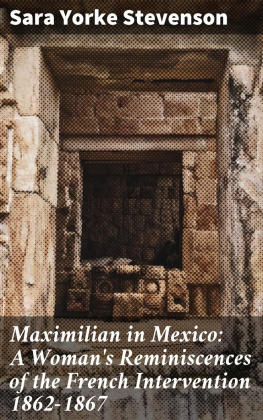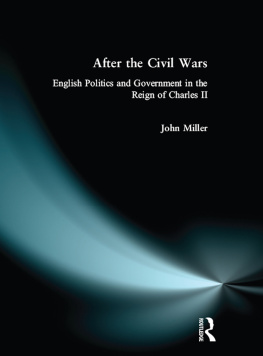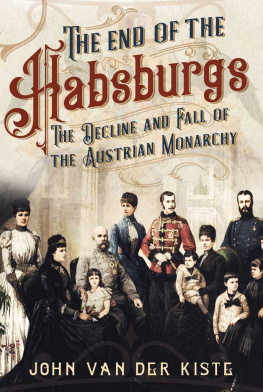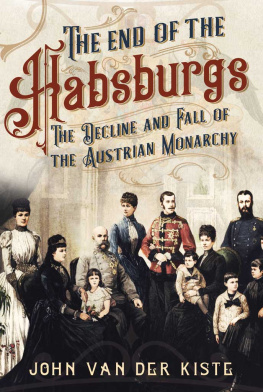ROUTLEDGE LIBRARY EDITIONS:
GERMAN HISTORY
Volume 1
MAXIMILIAN I
(14591519)
MAXIMILIAN I
(14591519)
An Analytical Biography
GERHARD BENECKE
First published in 1982 by Routledge and Kegan Paul Ltd.
This edition first published in 2020
by Routledge
52 Vanderbilt Avenue, New York, NY 10017
and by Routledge
2 Park Square, Milton Park, Abingdon, Oxon OX14 4RN
Routledge is an imprint of the Taylor & Francis Group, an informa business
1982 Gerhard Benecke
All rights reserved. No part of this book may be reprinted or reproduced or utilised in any form or by any electronic, mechanical, or other means, now known or hereafter invented, including photocopying and recording, or in any information storage or retrieval system, without permission in writing from the publishers.
Trademark notice: Product or corporate names may be trademarks or registered trademarks, and are used only for identification and explanation without intent to infringe.
British Library Cataloguing in Publication Data
A catalogue record for this book is available from the British Library
ISBN: 978-0-367-02813-8 (Set)
ISBN: 978-0-429-27806-8 (Set) (ebk)
ISBN: 978-0-367-22821-7 (Volume 1) (hbk)
ISBN: 978-0-429-27706-1 (Volume 1) (ebk)
Publishers Note
The publisher has gone to great lengths to ensure the quality of this reprint but points out that some imperfections in the original copies may be apparent.
Disclaimer
The publisher has made every effort to trace copyright holders and would welcome correspondence from those they have been unable to trace.
MAXIMILIAN I
(14591519)
an analytical biography
Gerhard Benecke
First published in 1982
by Routledge & Kegan Paul Ltd
39 Store Street, London WC1E 7DD,
Printed in Great Britain by
Redwood Burn Ltd
Trowbridge, Wiltshire
Gerhard Benecke 1982
No part of this book may be reproduced in
any form without permission from the
publisher, except for the quotation of brief passages in criticism
Library of Congress Cataloging in Publication Data
Benecke, Gerhard.
Maximilian I (14591519)
Includes bibliographical references and index.
1. Maximilian I, Emperor of Germany, 14591519.
2. Holy Roman Empire Kings and rulers Biography.
3. Germany History Maximilian I.14931519.
I. Title.
DD174.B46 943.0290924 [B] 82608
ISBN 0-7100-9023-4 AACR2
Contents
Maximilian lived for nearly sixty years. He established the fortunes of the House of Austria once and for all as those of a first-class European dynastic power. He married two of the richest women in the Europe of his day. He tried to establish hegemony in his capacity as Holy Roman Emperor Elect, even using culture and technology to help his cause. He controlled large parts of Austria, Germany and the Low Countries but never seemed to have a penny to his name. He mounted crusades, fought Turks on paper, and fought Swiss, Hungarian, French, Italian, Netherlands and German princes and burghers in reality. By turns he tried to ally himself with nearly every major and minor power in European diplomacy. At the age of eighteen he married the heiress of Burgundy, from the richest court in Europe; he was a widower at twenty-three, king in Germany as elected Rmischer Knig at twenty-seven, and German Emperor Elect at thirty-four. He subsequently set up the dynastic base of his grandsons, Charles V and Ferdinand I, through skilful marriage alliances with Aragon-Castille and Bohemia-Hungary.
Three biographies of Maximilian have appeared in English. The first, in 1902, was a brief essay; the second, a popular account of the kings, queens and battles variety, appeared in 1913. The third came in 1941 and dealt with its subject in terms of literary criticism. At school and university few late-medieval and early modern European history courses can avoid assessing the importance of the Holy Roman Empire under Maximilian I in the era of Renaissance humanism on the eve of the Lutheran Reformation. Yet only those who read German are able to piece together a substantial picture of Maximilian. It means reading a variety of works often only available in the really large national libraries. My aim is to help to fill this gap by presenting a biographical sketch based on analysis of some interesting themes, and not narrative, which may begin to show Maximilians place in the dynastic territorial Austrian, federal Reich German, and European dynastic, republican and ecclesiastical society of his day. I have concentrated less on dynastic-diplomatic narratives of Maximilians high politics, such as his French and Italian wars and policies. Instead, I have tried to give some insights into Maximilians style of home affairs and German-Austrian leadership, making use of the extant literature, supplemented by archive research of my own.
It is my aim once more to test against the evidence the prevailing view of Maximilians success as leader of Renaissance German society on the eve of the Reformation on the one hand, and failure as a European politician on the other. This Janus-headed ruler was neither medieval nor ultra-modern, but a shrewd operator in his own time and place: Machiavellis Prince and Castigliones Courtier all rolled into one, residing north of the Alps and date-stamped circa 1500. I have reconstructed the fiscal and social as well as personal impact of Maximilians style of government upon his territorial and federal subjects in Austria and Germany. It has involved a regional and case-study, local approach, centred, above all, on Innsbruck, Tirol and East Swabia, in order to pinpoint the underlying factors that in large measure determined the personal flavour of decisions taken to influence the broader issues of politics and control during the reign. Here we see a powerful ruler caught between feudal and commercial interests, satisfying both to a considerable extent by offering more standardised, bureaucratised, prerogative and proto-absolutist types of government. This applies especially to the nature of Maximilians personal administration; to the way in which he treated his own tenants and servants, so indicative of his wider political actions, preoccupations and attitudes as a Habsburg. The reader may hope to base his own evaluation upon the following analyses of a very vigorous style of governance, reconstructed from archives recording the decisions, writings and thoughts of Maximilian I himself, and of those close to him in holding the reins of power. In that task I have tried, however inadequately, to follow historians like Lacey Baldwin Smith, whose book, Henry VIII. The Mask of Royalty, published in London 1971, tells us that:
Henry was for ever of the happy conviction that every problem must have a direct and immediate solution. There is a singular lack of proportion to Henrys intellectual and emotional approach to life which might have been acceptable in an adolescent or understandable in an undergraduate but terrifying in royalty. (Panther paper edition, p. 102).













